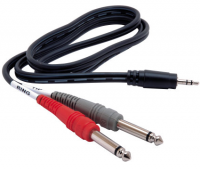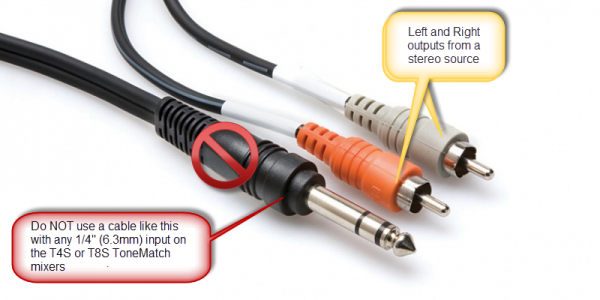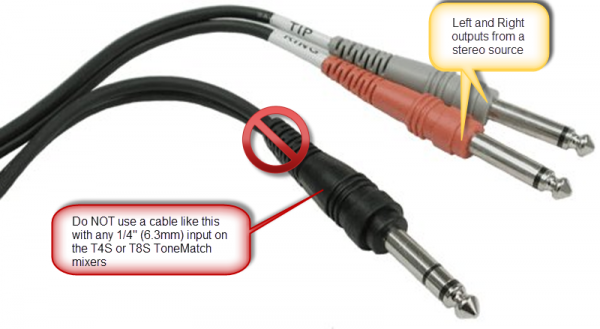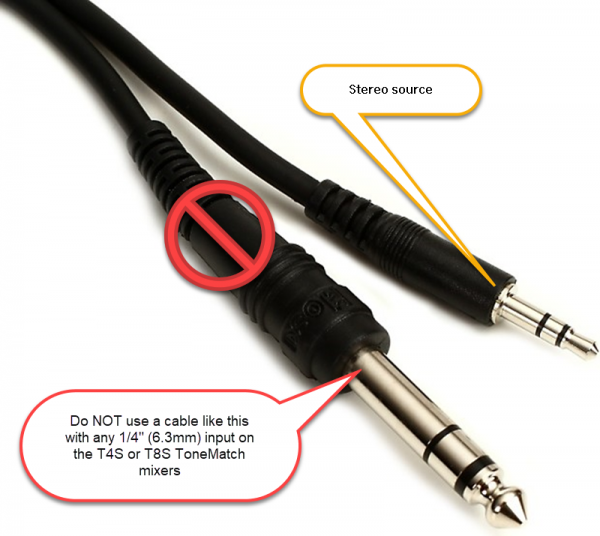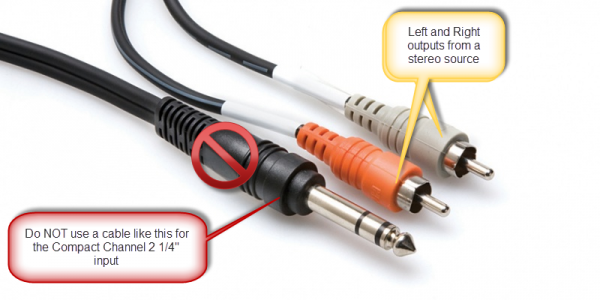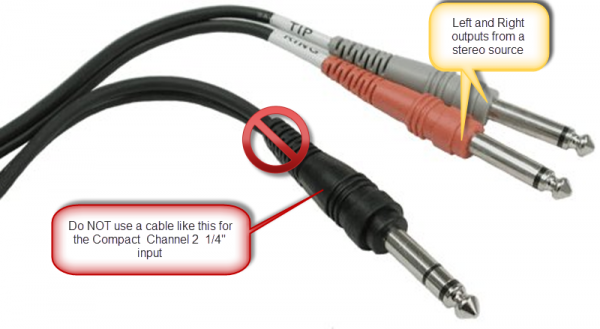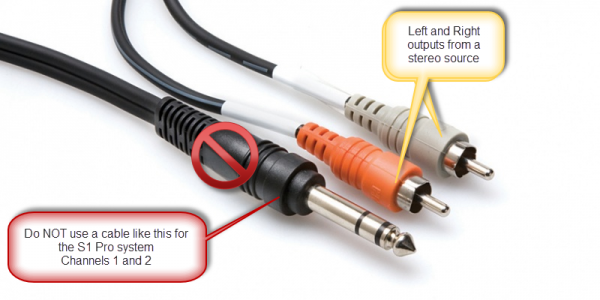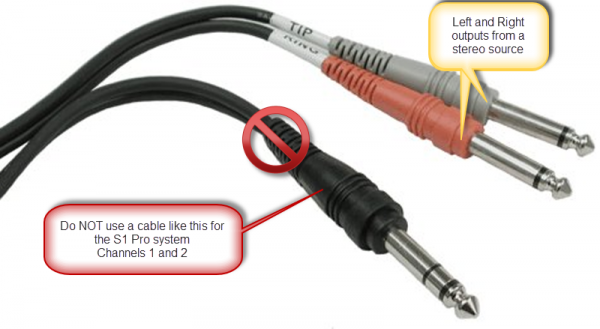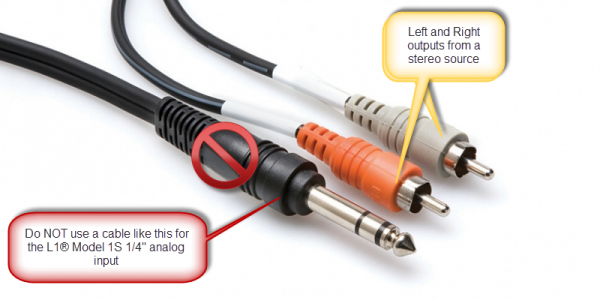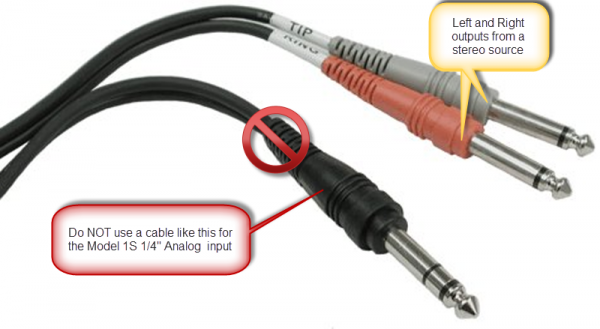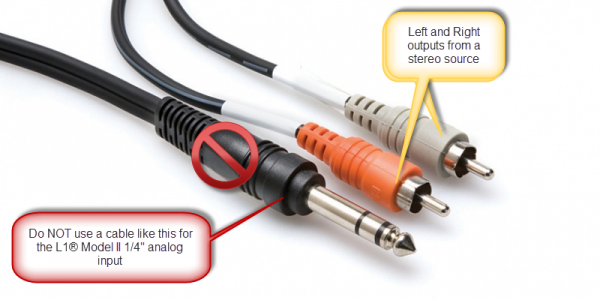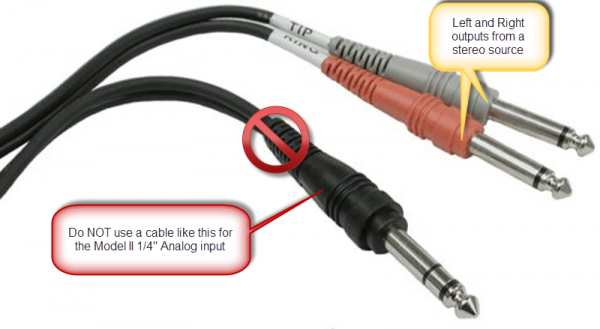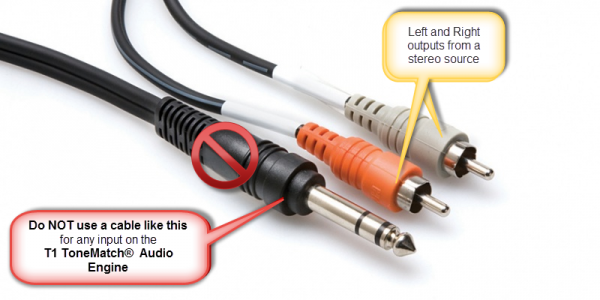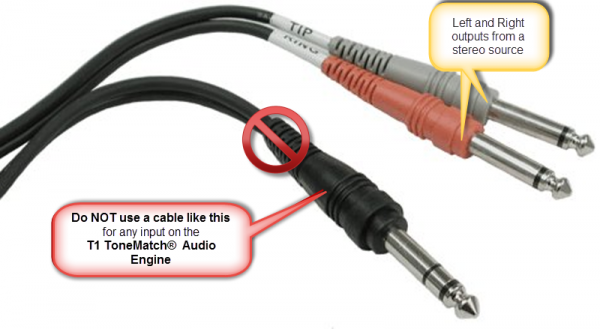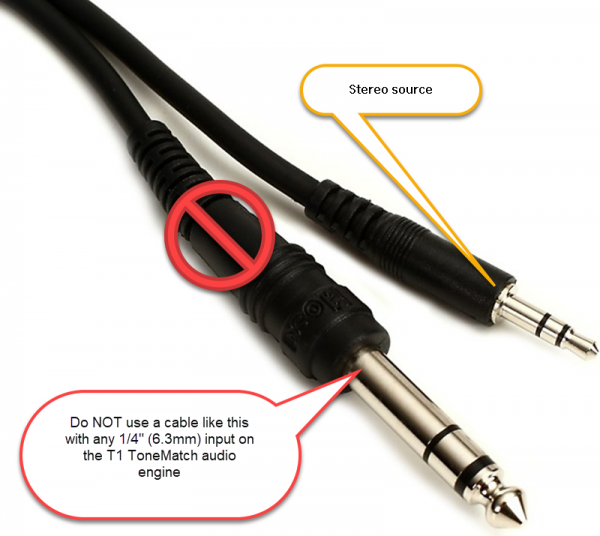Difference between revisions of "Stereo to Mono Conversion"
m |
m |
||
| (9 intermediate revisions by the same user not shown) | |||
| Line 3: | Line 3: | ||
<td valign="top"> | <td valign="top"> | ||
;Can I connect a stereo output to a mono input on a Bose Portable PA Product? | ;Can I connect a stereo output to a mono input on a Bose Portable PA Product? | ||
| − | :There are cables and simple converters to do this. ''We recommend that you don't''. Do one of the following: | + | :There are [https://www.amazon.com/slp/stereo-to-mono-adapter/pxpkk2fgdtrd4ts cables and simple converters] that claim to do this. ''We recommend that you don't'' use them (see [[{{PAGENAME}}#Introduction|details below]] about why you shouldn't). Do one of the following: |
| − | :*The {{ | + | :*The L1 Pro, {{S1}}, {{S1 Pro+}} and {{Compact}} have stereo 1/8-inch (3.5 mm) Tip-Ring-Sleeve Aux inputs. Use those stereo inputs. |
:*Split the stereo signal to two mono signals and connect to two separate mono inputs <br>[[File:18TRSto2x14TS.png|200px|Hosa CMP159 Stereo Breakout, 3.5 mm TRS to Dual 1/4 in TS, 10-Feet ]] | :*Split the stereo signal to two mono signals and connect to two separate mono inputs <br>[[File:18TRSto2x14TS.png|200px|Hosa CMP159 Stereo Breakout, 3.5 mm TRS to Dual 1/4 in TS, 10-Feet ]] | ||
| − | :*Convert the signal to mono at the source and use a simple Tip-Sleeve connector to the Bose Portable PA device | + | :*Convert the signal to mono at the source and use a simple Tip-Sleeve connector to the Bose Portable PA device. See:[[IOS Mono]], [[Android Mono]], [https://www.howtogeek.com/333367/how-to-make-your-windows-10-pc-use-mono-audio-so-you-can-wear-one-earbud/ Windows Mono] |
| − | :*Use a stereo to mono converter | + | :*Convert the signal to mono and if the output is balanced, use a 1/4 inch (6.3 mm) Tip-Ring-Sleeve or XLR to 1/4 inch (6.3 mm) Tip-Ring-Sleeve cable |
| + | :*Use a stereo to mono converter. Here are some examples: [http://www.radialeng.com/product/mix-21 Radial 2:1] or [https://www.amazon.com/Galaxy-Audio-JIBR-RCA-Combiner/dp/B005GJCA6M?ref_=fsclp_pl_dp_8 Galazy Audio JIBR RCA Combiner] or [https://www.google.com/search?client=firefox-b-d&q=DIY+stereo+to+mono+adapter build your own] | ||
</td> | </td> | ||
</tr></table> | </tr></table> | ||
| − | The following is an excerpt from [ | + | The following is an excerpt from [https://www.prosoundweb.com/rane-note-why-not-wye-or-y-for-that-matter/ Why Not Wye] |
===Introduction=== | ===Introduction=== | ||
| Line 31: | Line 32: | ||
Download the full article: [[Media:Why Not Wye.pdf|Why Not Wye.pdf]] | Download the full article: [[Media:Why Not Wye.pdf|Why Not Wye.pdf]] | ||
| + | |||
| + | === L1 Pro === | ||
| + | {{L1 Pro icon}} | ||
| + | {{Why Not Wye Explanation}} | ||
| + | |||
| + | All of the following images apply to the L1 Pro models as well as ToneMatch mixers. | ||
| + | |||
| + | [[Image:TRSfromStereoRCAT4ST8S.png|600px]] | ||
| + | |||
| + | [[Image:TRSfromStereo14T4ST8S.png|600px]] | ||
| + | |||
| + | [[Image:18trsto14trsT4ST8S.png|600px]] | ||
| + | |||
| + | [[Image:XLR Female x2 to 14trs.jpg|600px]] | ||
=== Compact === | === Compact === | ||
| Line 46: | Line 61: | ||
{{Why Not Wye Explanation}} | {{Why Not Wye Explanation}} | ||
| − | * If your source has RCA outputs, use a standard RCA- | + | * If your source has RCA outputs, use a standard RCA to 1/8 inch Tip-Ring-Sleeve |
| − | * If your source has a 1/8" stereo output, use a 1/8" Tip-Ring-Sleeve cable to connect to the | + | * If your source has a 1/8" stereo output, use a 1/8" Tip-Ring-Sleeve cable to connect to the S1 Pro Aux 1/8" input. |
Latest revision as of 21:25, 22 February 2025
|
The following is an excerpt from Why Not Wye
Introduction
Wye-connectors (or "Y"-connectors, if you prefer) should never have been created.
Anything that can be hooked-up wrong, will be. You-know-who said that, and she was right. A wye-connector used to split a signal into two lines is being used properly; a wye-connector used to mix two signals into one is being abused and may even damage the equipment involved.
- Here is the rule: Outputs are low impedance and must only be connected to high impedance inputs -- never, never tie two outputs directly together -- never. If you do, then each output tries to drive the very low impedance of the other, forcing both outputs into current-limit and possible damage. As a minimum, severe signal loss results.
- Subwoofers
- Monoing Your Low End
One of the most common examples of tying two outputs together is in "monoing" the low end of multiway active crossover systems. This combined signal is then used to drive a sub-woofer system.
Since low frequencies below about 100Hz have such long wavelengths (several feet), it is very difficult to tell where they are coming from (like some of your friends). They are just there -- everywhere. Due to this phenomenon, a single sub-woofer system is a popular cost-effective way to add low frequency energy to small systems.
So the question arises as how best to do the monoing, or summing, of the two signals? It is done very easily by tying the two low frequency outputs of your crossovers together using the resistive networks described below. You do not do it with a wye-cord.
Download the full article: Why Not Wye.pdf
L1 Pro
Here is the rule: Outputs are low impedance and must only be connected to high impedance inputs -- never, never tie two outputs directly together -- never. If you do, then each output tries to drive the very low impedance of the other, forcing both outputs into current-limit and possible damage. As a minimum, severe signal loss results.
All of the following images apply to the L1 Pro models as well as ToneMatch mixers.
Compact
Here is the rule: Outputs are low impedance and must only be connected to high impedance inputs -- never, never tie two outputs directly together -- never. If you do, then each output tries to drive the very low impedance of the other, forcing both outputs into current-limit and possible damage. As a minimum, severe signal loss results.
- If your source has RCA outputs, use a standard RCA-RCA cable to connect to Compact Channel 2 RCA inputs.
- If your source has a 1/8" stereo output, use a 1/8" Tip-Ring-Sleeve cable to connect to the Compact Channel 2 1/8" input.
S1 Pro system
Here is the rule: Outputs are low impedance and must only be connected to high impedance inputs -- never, never tie two outputs directly together -- never. If you do, then each output tries to drive the very low impedance of the other, forcing both outputs into current-limit and possible damage. As a minimum, severe signal loss results.
- If your source has RCA outputs, use a standard RCA to 1/8 inch Tip-Ring-Sleeve
- If your source has a 1/8" stereo output, use a 1/8" Tip-Ring-Sleeve cable to connect to the S1 Pro Aux 1/8" input.
Model 1S
Here is the rule: Outputs are low impedance and must only be connected to high impedance inputs -- never, never tie two outputs directly together -- never. If you do, then each output tries to drive the very low impedance of the other, forcing both outputs into current-limit and possible damage. As a minimum, severe signal loss results.
Model II
Here is the rule: Outputs are low impedance and must only be connected to high impedance inputs -- never, never tie two outputs directly together -- never. If you do, then each output tries to drive the very low impedance of the other, forcing both outputs into current-limit and possible damage. As a minimum, severe signal loss results.
T1 ToneMatch® Audio Engine
Here is the rule: Outputs are low impedance and must only be connected to high impedance inputs -- never, never tie two outputs directly together -- never. If you do, then each output tries to drive the very low impedance of the other, forcing both outputs into current-limit and possible damage. As a minimum, severe signal loss results.
T4S/T8S ToneMatch Mixers
Here is the rule: Outputs are low impedance and must only be connected to high impedance inputs -- never, never tie two outputs directly together -- never. If you do, then each output tries to drive the very low impedance of the other, forcing both outputs into current-limit and possible damage. As a minimum, severe signal loss results.
